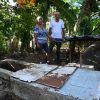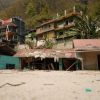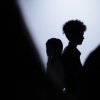Monday, April 29, 2024
News and Views from the Global South
Democracy
Religious Youth Could Swing Pakistani Poll

Students at the NED Engineering University in Karachi, Pakistan, argue about “conservative” versus “secular” dress. Credit: Adil Siddiqi/IPS
- From the local butcher, to the pavement fruit vendor, to the cobbler sitting beside his tools on Elphinstone Road, a busy street in the heart of Karachi, one question is on everyone’s lips: Who will win the upcoming elections on May 11?
 In Pakistan, a country that is reeling from the Taliban’s militancy in the north, rampant corruption in the government and an armed force that has a life of its own, few have the answer to this question.
In Pakistan, a country that is reeling from the Taliban’s militancy in the north, rampant corruption in the government and an armed force that has a life of its own, few have the answer to this question.
But one thing is certain: for the first time in Pakistan’s history, young people between the ages of 18 and 29 – who currently comprise well over half of the country’s population of 170 million people — will play a pivotal role in determining the election outcome.
A nationwide survey of 4,450 young people, carried out by the Islamabad-based Free and Fair Election Network (Fafen) back in January, showed that only 48 percent of voters aged 18 to 25 intend to vote, putting them far behind other age groups: in contrast 68 percent of those between 26 and 35, and 84 percent of those above 55, said they would cast their ballots.
Many young people, like filmmaker Abida Sharafat, are jaded. “I don’t want to elect people who will come (into power) for five years to oppress and exploit us,” she told IPS, referring to the number of politicians who have been exposed as major loan defaulters and tax evaders.
Mohammad Shafi, a barely literate 27-year-old domestic helper working in an upscale Karachi neighbourhood, says the government of the ruling Pakistan People’s Party (PPP) “emptied our pockets and increased violence” over the last five years.
A recent poll conducted by the British Council (BC) on Pakistani youth found that more than half of 5,000 respondents between 18 and 29 years believed that “democracy” – a term that has been bandied about by the centre-left PPP – has not been a good form of governance here.
Sixty-four percent of male responders and 75 percent of female responders described themselves as “conservative” or religious.
Echoing what appears to be a growing trend among the youth, Shafi told IPS he would “prefer the country to be governed by Sharia law”, adding quickly: “But not the Sharia the Taliban wanted imposed in Swat (an administrative district of the northern Khyber Pakhtunkhwa province) but one which promotes equity and justice.”
Sharafat insists that the tenets of religious law come “closest to the socialist values to which I subscribe”. For instance, Zakat, one of the five pillars of Islam, prescribes the giving of a percentage of one’s wealth as “tax” to the government or the needy.
The widespread existence of similar opinions among the youth is borne out in the BC study, whose findings, according to Lahore-based senior defence and political analyst Dr. Hasan Askari Rizvi, come as “no surprise”.
“The Pakistani youth’s conservative and Islamic orientation can easily be detected (in) their idiom and historical references,” he told IPS, adding that Arabic phrases like “Allah Hafiz” (“may God protect you”) have come to replace Persian-language expressions like “Khuda Hafiz” in the daily spoken language.
Dr. Pervez Hoodbhoy, a physicist and renowned peace activist with over three decades of teaching experience, blames this shift on the Islamisation of Pakistan’s education system, which was imposed by former dictator Muhammad Zia-ul-Haq in the 1980s.
Over the generations, he says, students have “forgotten how to sing, dance, or act – the fear of having their heads cracked open by violent fundamentalists has worked well”.
Few of his students at the Quaid e Azam University in Islamabad have a thorough command of any language and few read anything beyond newspapers. Today’s texts are devoid of references to early recorded history, the Nile Valley Civilisation and Greek and Hindu mythology, he added.Even when the government has tried to offset religious extremists in the education sector, they have been forced to make a U-turn. When the government of Punjab commissioned a new Urdu language textbook for the 10th grade a few months ago the conservative media relentlessly attacked the book for having “expunged” Islamic teachings.
To the contrary, Hoodbhoy found that the very first chapter in the offending book was a “hamd” (a poem in praise of God) and the second was a “naat” (a poem in praise of Prophet Muhammad). Also included were letters from Ghalib (a famous Urdu poet), and a fairytale.
But under intense pressure from right-wingers, the state “retreated and promised to reinsert essays on jihad and Islam”, Rizvi said.
This Islamised education has tipped young people towards a “pro-militant” and “anti-U.S.” mindset, he added.
“They tend to see themselves more as Muslims than as Pakistanis; most see the West as being responsible for their problems.”
Clothing has now begun to reflect the increasingly conservative values of the youth. Sharafat, who wears traditional Pakistani dress but does not cover her head, noted, “The number of long, untrimmed beards and black abayas (robes) have multiplied enormously among young people.”
“I feel I am now among the minority,” said Sharafat, adding that her decision to leave her head uncovered “graphically” exposes her secular and liberal thoughts. “I often have to explain to my friends that I am as much a practising Muslim in my private life as they are in their public ones.”
But not everyone is convinced this trend is so easily quantifiable. Mohammad Shehzad, an Islamabad-based writer and researcher, believes the BC survey was conducted with certain objectives in mind, which might have compromised its objectivity.
“The survey has been used by Islamists to support their outrageous claim that the majority needs Sharia,” Shehzad told IPS.
Salima Hashmi, an artist and interim minister in the Punjab caretaker government, is inclined to agree. A former principal of the National College of Arts in Lahore, she insists that “free thinking and liberal aspirations” among fine art students have not completely been quashed, adding that the “spirit of inquiry” is alive and well.
However, she fears that when institutions are left rudderless, like the NCA has been over the last four years, with no governing body, the “chaos” prevailing outside is all the more likely to creep in.
-
Ashley Barr

 Print
Print



